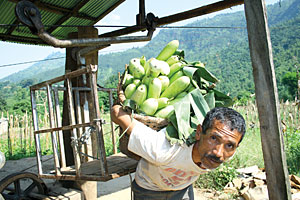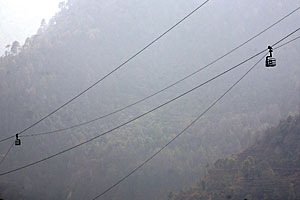 MARK ZIMMERMAN Photo from the carriage with legs dangling above Chitlang Valley |
During the years I worked in Patan Hospital, on my off-days I used to hike in the hills southwest of the valley - along the ridges leading up to the mountain Champadevi. I always appreciated escaping the noise and dirt of Kathmandu, but one day in November 1995 stood out above all the rest.
That morning, when two friends didn't show up at my house as planned, I almost didn't go. But I decided to ride the bus by myself out to Thankot and began walking up in the forest towards Chandragiri. After more than an hour of steady climbing, I crested the hill and looked across towards the village of Chitlong in the distance. This was the old walking route from India, on which decades before crews of 40 or 50 porters would carry automobiles into the isolated Kathmandu Valley. The air was fresh and sweet as I turned east and headed along the ridge trail, alternately catching glimpses of rural villages to my right, the crowded valley to my left, and beyond that the Himalaya.
Another two hours on, I came up over a hill and as I stopped to catch my breath, there it stood below me: the Ropeway. Constructed in the 1980s, this cable car system carried goods back and forth over the 60 miles between Kalimati in Kathmandu and Hetauda to the south on the Terai. I watched the cars come rhythmically through the station and then float off into the air over the fields and villages of Makwanpur District. I'd walked past the place before, but on this particular day it was an arresting sight and an idea took hold. What's stopping someone from just jumping on a car and riding it down to the Terai?
I walked slowly down the hill towards the power station, plotting the moves that would be required, but before I could act a man came out from the station and greeted me. Soon he was joined by his colleague. These two older men were both friendly, but now my plan of simply hopping a car- freight train style- seemed impossible. They saw my camera and asked me to photograph them while they sat at the controls of the station, then urged me to sit and have my photograph taken.
"I want to go to Hetauda on one of these cars," I said.
Puzzled at first, they then began to give serious consideration to my demand. They seemed to think I was on some sort of official business. I neither confirmed nor denied this, only saying that I was from Patan Hospital.
One of them picked up his phone and was soon speaking, "There's a foreign sahib over here. We're going to be sending him along to you." More conversation transpired; it seemed to be proceeding in a positive direction.
Then another man showed up. Whether he was an employee or not, he assessed the situation and said to me, "These cars are old and dangerous. They sometimes fall off the cable." The balance was beginning to tip against me (as perhaps it should have), but the vision had already captivated me. I asked more about the actual risk and continued to urge them on. Ten or twelve village kids formed a circle around us at the station. The new man finally said, "Better send him up to meet the boss."
One of the operators led me through the station and up the hill to a small concrete shed. Inside we found a man sleeping on a bare wooden bed, a burlap bag filled with plastic bottles for his pillow. The dimly-lit room smelled of alcohol. "The boss" sat up unsteadily and regarded me.? He was a thin man of about thirty.
"I want to ride the Ropeway down to Hetauda."
"Where are you from?"
"Patan Hospital."
"Impossible. It's for goods, not people. Cars sometimes fall off."
"How often does a car actually fall off?"
"Maybe about once every 2 or 3 months."
Getting more information about the daily number of cars, I calculated the random risk to be no more than 1 in 4,000 trips. To me these odds seemed unlikely enough, but the boss appeared to be unmoved. I walked outside and sat on the steps, chatting with the locals, answering the usual litany of questions to do with my number of years in Nepal, work, salary, age, marital status, where I learned Nepali, etc. Reason did not overtake me, so I waited. About an hour passed. It was noon.
One of the operators walked up again, entered the boss's hut, and after some time came out to me. "Boss says you can go if you sign an insurance form."
"Where do you get one of those?"
"Down at the office in Kathmandu."
"There's no way I can walk down there now. How about it I sign one of these Patan Hospital forms?" I produced a referral slip for the hospital clinic, something I always carried in my backpack. I wrote on it in Nepali, "I take full responsibility for anything that may happen to me while on the Ropeway," and signed it.
The man took it in to the boss and they both came out to me. The boss seemed alert now. He stood beside me and said, "OK. You can ride the Ropeway. I'll go too." We walked down to the station. As the boss spoke to the operators, a crowd of about a hundred village people formed on an overlooking knoll. Cars came through moving in both directions, some loaded with sacks, some empty. The operators stopped 3 or 4 empty cars in turn, rejecting each as being 'not good'. Finally they stopped a car that passed everyone's muster. The boss motioned for me to go first and we climbed on.
Ropeway cars were palettes about 8 by 10 feet in size, with a floor of wooden planks separated by 4-inch gaps. In the front and back were retaining bars. A steel arm with rollers at the top curved up over a supporting cable, and a second cable that was connected to the power stations pulled the car along. Rather than hugging the contour of the hills, the cables extended horizontally, with only a slight bow, towards the next mountain peak. The boss and I sat side-by-side facing forward and holding firmly onto the front bar.
Within moments, we were airborne. A cheer rose from the crowd behind us and quickly faded into the distance. My euphoria gave way to fear. I looked over at the boss, who seemed as uncertain as I felt. We began to make continuous small talk to calm ourselves. His name was Krishna. We were 200 feet, 300 feet and climbing above fields and houses, moving in complete silence across the sky. I suggested we say a short prayer together, to which Krishna agreed.
"How many times have you ridden this, Krishna?"
"This is my first time. People don't usually ride it."
"Does it ever get stuck?"
"Sometimes, but not always."
 DARE DEVIL: Mark Zimmerman recalls how he was once a stowaway on Nepal's now-defunct cargo cable car from Kathmandu to Hetauda and lived to tell the tale. |
My nerves began to steady as we finally approached the first mountain, a cut in the trees where two towers stood. We glided in, briefly smelled the pines, and then launched off into the space beyond.
This needs to be documented, I thought. I pulled my camera out and took photos of the land passing below. I felt deeply in love with this country, a place where it was possible to just take off and ride over the hills.
About half way out from that first mountaintop, the car jarred, wobbled slightly in the air, and finally settled. I surveyed the lines of cars behind and in front, all of us now hanging motionless.
"How long will this take?"
"It's hard to say."
I took stock of my provisions- half a bottle of water, one sandwich and two tangerines. I looked at my watch. What if this takes days? Feigning nonchalance, I offered Krishna a tangerine. We spat the seeds into the air and watched them float down beyond our sight. While sitting still, we seemed higher in the sky, more vulnerable. The minutes expanded.
Then our car lurched forward and we were flying again.
We crossed four or five more mountains. Each passing was sublime. Kids ran up and gave 'Namastes'. A chowkidar by the tower waved. We took in the green and brown details of earth, a village house or two, and then glided away.
After about 45 minutes, the forests and yellow mustard fields were interrupted by a wide swath of shimmering blue, more water than one usually sees in Nepal. "Kulekaani," Krishna said. The reservoir for the hydroelectric plant.? "There's a power station here. The car will stop."
I'd already been considering how, if I rode this all the way to Hetauda, I was going to be able to make it back to work the next day. "I think I'm going to get off here," I said. "So will I," said Krishna.
Our car stopped inside the power station where Krishna exchanged greetings with the operator. Firm earth under our feet, we walked out into the afternoon sunlight. I thanked Krishna and gave him a small tip, then took directions for my hike back to Kathmandu. Before heading home, I turned for one last look and stood for a moment to watch the cable cars glide off into the quiet mountains.
Learning the ropes
 PRACTICAL ACTION |
Practical Action Nepal is working with communities across the country to build gravity ropeways. The design beats gravity with a simple law of physics: two linked trolleys run on steel wires suspended from towers. As the trolley packed with vegetables comes down pulled by its load, it pulls the empty one up by its weight, ready for the next load.
Gravity ropeway was first used in Mustang six years ago to make apple transportation faster and cheaper for the locals. Since then it has made its way to four other locations, Gorkha, Tanahun, Kalikot and Achham, connecting upland villages to the highways on the valley floor.
"We apply technology as a means for poverty alleviation," says Practical Action's Achyut Luitel.
An example is the Fishling-Bhumichowk gravity ropeway in Gorkha which cuts the transportation time from five hours to three minutes. It has increased farmers' income and in less than a year every household using the ropeway has earned more than Rs 50,000 from vegetable sales.
A gravity ropeway extending about 1.5 km costs Rs150,000, far cheaper than building a road that costs twice as much per km. Ropeways are also more environmental-friendly and even work in the rainy season.
Practical Action has plans to build six more gravity ropeways and the Ministry of Local Development may soon be introducing the technology to ten other districts.
Cable car history
 |
The nearly 31km long Dhorsing-Matatirtha ropeway was an impressive piece of engineering for its time, built in the 1930s. But even that was the second ropeway in Nepal. The first in 1924 was the 4km Halchowk to Lainchaur ropeway bringing stones from a quarry to feed the Rana's palace-building spree.
The American-built 42.3km Nepal Ropeway from Hetauda to Kathmandu served Kathmandu's needs well until it fell victim to corruption and bad management. It did work one last time in 1994 when monsoon landslides marooned Kathmandu for a month. Despite the potential, no major cargo cable system has been built in Nepal. The private Manakamana Cable Car is the only successful model for passenger ropeways.
READ ALSO:
Rust in peace- FROM ISSUE #209 (13 AUG 2004 - 19 AUG 2004)


